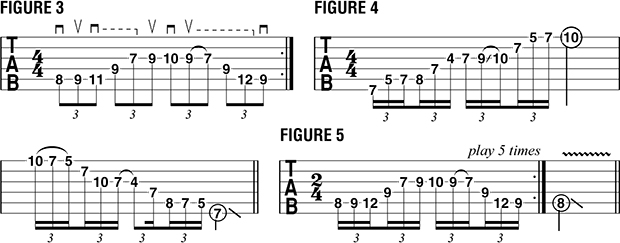A New Approach to the Blues Scale
Create unique and distinctly challenging licks and runs with this different approach to the blues scale.

If I had to choose my favorite scale for soloing, it would be the blues scale, that cool, slippery scale that adds the flatted fifth (f5) to the minor pentatonic. Among traditional players and modern shredders, it is probably the most commonly used scale in blues and rock.
This month, I’m going to revisit the wide fret-hand stretching techniques we’ve examined in previous lessons and apply them to the blues scale on different areas of the fretboard to create very unique and distinctly challenging licks and runs. These kinds of licks can be applied to a great variety of musical styles, from blues to rock to jazz to metal, and they don’t have to be played at warp speed with maximum gain to sound cool.

For reference, FIGURE 1 illustrates the B blues scale (B D E F F# A) as played in its seventh-position “box” pattern. In the following examples, I use wide stretches to combine adjacent, overlapping scale positions, which enables me to create unusual phrases and melodies. The incorporation of sweeps and economy picking enhances my ability to execute these runs very quickly.
FIGURE 2 introduces the first lick, and here I incorporate a three-string arpeggio, one note per string, moving from the A string to the G string using sweep picking. In bar 2, I use an upward sweep across these strings, along with two essential pull-offs. You’ll notice that there is a bit of a random, “cramming” quality to the phrasing, especially in bar 1.
Keep in mind that the only way to execute wide stretches such as these is to keep the fret-hand thumb positioned squarely on the back of the neck, which allows the fingers to come down at a very straight angle to the strings. This will also allow a greater fretting span than what can be achieved when wrapping the thumb over the top of the fretboard, as you might do when bending strings. Try to keep the fret hand as relaxed as possible.



A great way to practice a phrase like this is to cycle a small part of it, as shown in FIGURE 3. FIGURE 4 offers a similar approach but moved down one scale position. FIGURES 5 through 8 illustrate this approach applied to four more areas of the fretboard, with different fretting options and melodic shapes offered.


Our last two examples demonstrate how I might apply these different shapes to a longer soloing idea. In FIGURE 9, I begin in fifth position but quickly move up to seventh while applying some very wide stretches. In FIGURE 10, I essentially remain in seventh position, but the stretches are again wide and will require practice to execute with speed and facility.
All the latest guitar news, interviews, lessons, reviews, deals and more, direct to your inbox!
